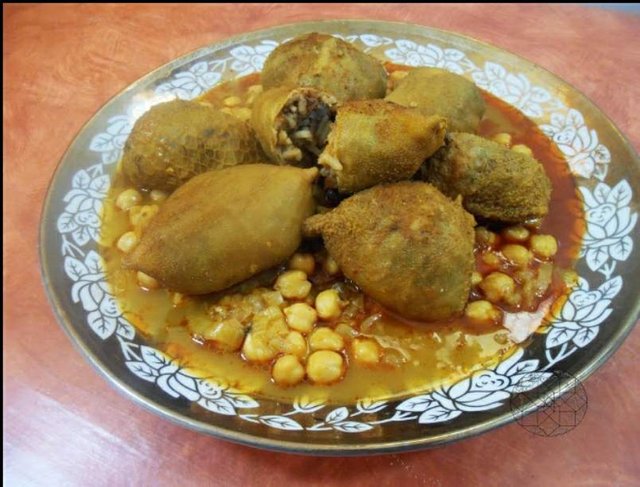"Bacbuca" .. a solid dish of Moroccan families
The "Bokokka" dish is one of the local customs and traditions that have been firmly established in the families of the past generations. Every year, the Eid al-Kabir is celebrated. The women are keen to prepare this dish, which is an expression of pride in the customs and traditions stemming from the ancient local heritage. , And a main meal wrapped around the family members in a festive atmosphere of joy, warmth and family cohesion.
On the first day of Eid al-Adha, my grandfather's house is barely empty. This dish is a "platter" stuffed with a mixture of liver, lung, intestines and meat parts, with stirring rice and spices before being cut with needle and white thread and cooked in saucepan and served in a decorated dish With chickpeas.
The researcher in the heritage of the Eastern Region Yahya Belkhu that the emotional woman on the days of Eid al-Adha special affair, as diligently and diligently prepare and prepare for the dishes of the dishes, especially "Bakbukp" which is around the opportunity to reunite the family and collect their assets and branches at one table in a meeting Less in normal days.
He explained that "Albbokp" is the second usual food for the families of the emotional intake in the food after the afternoon of the first day of the feast, after the meal "cabbage" (ie, the liver wrapped in grease after barbecue), and gather members of the family in a festive atmosphere accompanied by cups Of canned tea after it is cooked over the "fireplace" made of yellow soil from the quarry Sidi Yahya, which disappeared today Bojdp.
To this day, the families of the family have preserved the "baccalaureate" as one of the traditional dishes of Eid al-Adha, while many of the ancient customs and traditions that embody the distinctive ceremonial nature of this great religious occasion have disappeared.
Belkhu says that the two preparations for Eid al-Adha start from the first days of Shawwal immediately after Eid al-Fitr, through the purchase and fattening of sheep according to the number of families in the same house at a time when Oujda was a semi-urban city. In the surrounding "gardens".
He added that the men, a few days before the holiday, were carrying their knives wrapped in thick cloth for fear of the French colonial authorities, for the age at the "teacher" of Hassan Sousi or "my uncle for good," as many would like him, known for his wooden wheel, which sees half In his workshop at the yard of Sakaya Abdullah bin Omar near the Great Mosque, pointing out that the rotation of the wheel of large wood and flying sparks of them indicate that the "big feast" at the doors.
The children of the neighborhood meet in the squares of the old city (Aharash square, the courtyard of the mosque of Haddadah and others), and shout loudly, "Tomorrow is a feast, we are going to live a long life," said Mr. Belkhu, who explained That this mysterious and strange text often symbolizes "living" to the female lamb and any sheep and "happy" to the ram or sheep of sheep,
The sacrificial animal, whether it is 'Aisha' or 'Sa'id', should be given a special honor on the night of the feast, in which the henna is recited on the head or forehead of the sheep, as is still the case until today, as a sign of time and celebration of the sacrifice. Depriving her of drinking water so that she can empty her stomach and stomach after slaughtering her.
On the morning of Eid, which embodies the meanings of solidarity and solidarity and renews the link of the uterus, people wear their favorite traditional costumes for mosques and chapels to perform the Eid prayer, which is an occasion to exchange greetings and blessings among worshipers before returning to their homes to slaughter the sacrifice in a festive atmosphere attended by all members of the family.
According to Belkhu, who has also mentioned that some of the two children, who have eaten the sacrifice on the second day of Eid, keep the right shoulder of the sheep called " They kept the "board" or so-called "bone to shoulder" of divination and clairvoyance.
He explained that the "fortune-teller" was passing through the "pathways" to read what the shoulder bone suggests to him when he stirs him in the direction of the sun, adding that this clairvoyant foreman, who performs his mission in the presence of all members of the family, usually utters things that delight the listener to enjoy his generosity and generosity.
Sometimes the women, in addition to drying the intestines of the udhiyah, cut the meat in the form of slices or chips coated with oil and salt to turn it into a "scoop" and spread on a string to dry under the sun and keep to eat during the winter with "Berkuk" or vegetables.
In the context of the phrase "Nafru Lulidat", which has long been echoed by families, the children of the one way, especially the old Bujdah, the so-called "Khalawt" is a collective meal, which contributes to each child or child share of meat and enjoy the enjoyment in a joyful atmosphere, leaving another date For the same meal at the next Eid al-Adha.

Posted using Partiko Android
Thank you so much for being an awesome Partiko user! We have just given you a free upvote!
The more Partiko Points you have, the more likely you will get a free upvote from us! You can earn 30 Partiko Points for each post made using Partiko, and you can make 10 Points per comment.
One easy way to earn Partiko Point fast is to look at posts under the #introduceyourself tag and welcome new Steem users by commenting under their posts using Partiko!
If you have questions, don't feel hesitant to reach out to us by sending us a Partiko Message, or leaving a comment under our post!